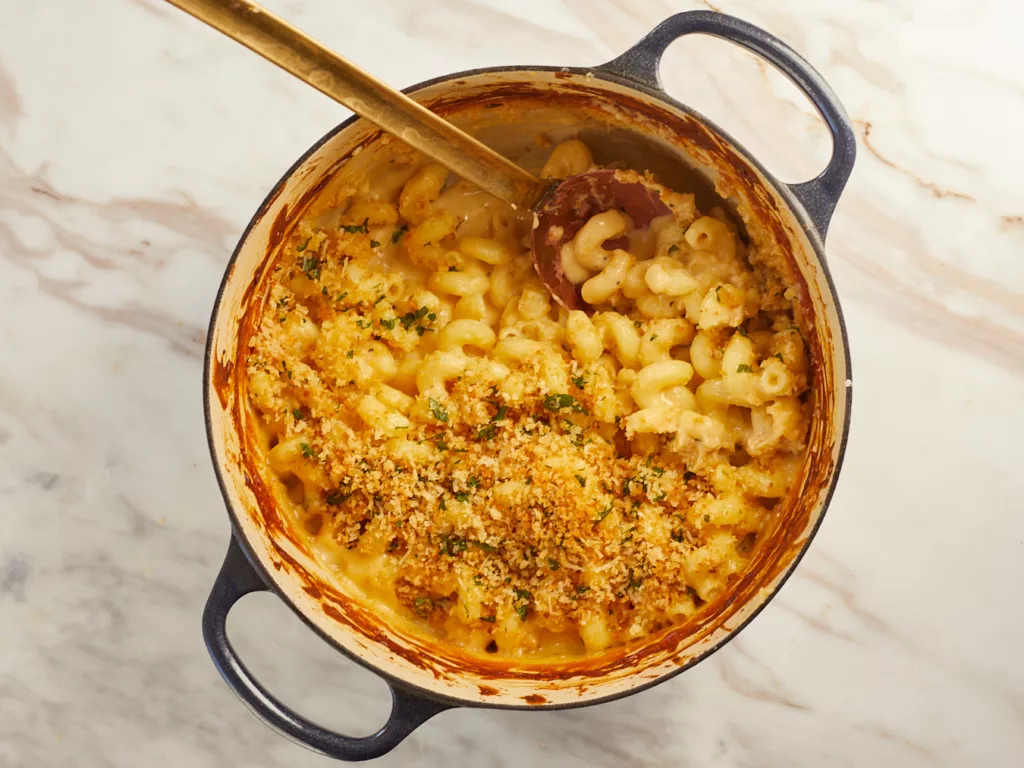
Why was this 4-Cheese Mac and Cheese one of the hardest recipes I’ve ever developed? A while back I mentioned that I had a mac and cheese recipe that I had been toying with, and people cried out on Instagram, desperate for it. (Okay maybe like 5 people asked me for it, but still!) I had already developed a recipe for fried mac and cheese bites, and I thought those would be great as a starting-off point for a baked entree version.
It did not end up being that simple. The first test was just way too creamy with Monterey Jack and cream cheese. It just glued your mouth shut and simply didn’t have enough flavor. The next three tests my cheese sauce split and became gritty and soupy. I’ve never been more frustrated during recipe testing—perhaps because I thought this dish was simple. But the more batches I made ($100 in cheese down the drain) and in-depth research (combing through every mac and cheese recipe online), I found two things. Not only can people can wildly vary on how they prefer their mac and cheese (crusty cheesy topping or breadcrumbs? baked or stovetop? swimming in sauce or casserole vibes?) but also there are many ways a creamy cheese sauce can go totally sideways.
But that’s what I wanted: a creamy cheese sauce, baked under a blanked of crusty cheesy breadcrumbs. That was the prompt. And that’s what we got — but keep reading to learn about the common pitfalls and pro-tips so you can avoid dry, soupy, grainy and gritty, curdled or BLAND mac and cheese.
(And by the way, it’s a 4-cheese mac and cheese thanks to the parmesan-panko breadcrumbs, plus cheddar, fontina and gruyere in the ultra-luxurious sauce.)
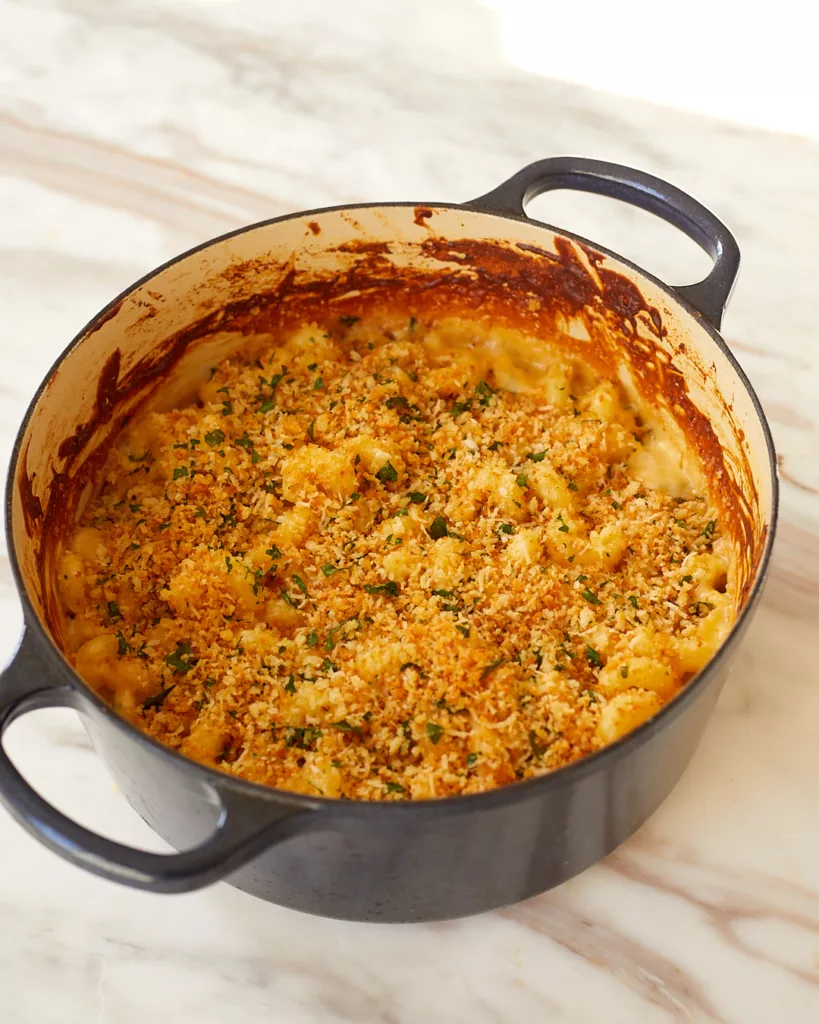
Why does cheese sauce curdle or split?
Like other emulsions such as mayonnaise or even chocolate ganache, cheese sauce is made of liquids that normally do not like each other, that are mixed together. I’ll spare you any more science-y talk, but the main culprits in curdled or split mac and cheese are too much heat and what kind of cheese you use. When you toss a bunch of cheese all at once into a béchamel mixture (milk-cream-roux) that’s too hot (I like to keep the temp between 140 and 180°F) the sauce will split. Using high-quality, melty cheeses can help make sure that you’re only cooking the milk and cream and roux hot enough to melt the cheese, and that you don’t need to stir it a lot or keep it cooking for longer than it needs to.
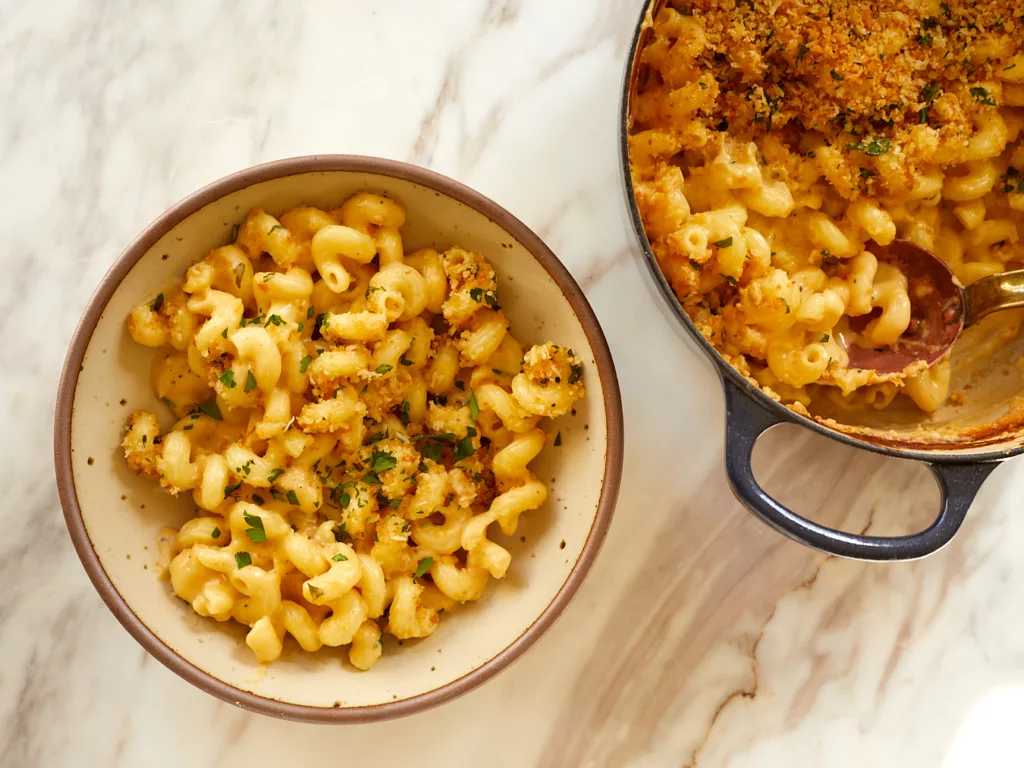
What cheeses are best for mac and cheese?
Here are some things right off the bat to look for — or avoid:
- DO spring for high-quality cheese. There’s little else in this recipe but some milk and cream and $1 worth of pasta so for taste and texture, drift towards the cheese counter and away from the refrigerator case.
- DO look for buttery cheeses with minimal bounce or spring. I don’t know how to describe it better, but the cheeses that melted into the sauce the best had a buttery, crumbly, creamy texture. Many cheddars from the refrigerator case, the ones pre-wrapped in plastic, had a rubbery quality to them that consistently made them near impossible to dissolve in the béchamel.
- DO NOT use pre-shredded cheese. I know it’s tempting. Don’t. These strands are covered in starches and other additives to prevent the cheeses from melting, which we want the opposite of.
Here are the cheeses I found dissolved the best into the béchamel mixture. Some of them I use in this recipe and some would might be good for experimenting or use in other recipes. This is not an exhaustive list.
The best cheeses for mac and cheese:
- White cheddar (I used Kerrygold Kilaree)
- Fontina (I used Mitica Fontina Val D’Aosta)
- Gruyere (I used Emmi Cave-Aged)
- Cream cheese (the real stuff in the block, not the spread)
And here are a few I tried and would avoid:
- Jarlsberg (or other Swiss style cheeses): these melt into beautiful, stretchy strands but don’t dissolve into the sauce as well as I was hoping. Layering them in between layers of the sauce-y noodles would be a good way to incorporate the cheese pull and Swiss flavor.
- Parmesan, pecorino romano, grana padano: Absolute flavor bombs but still lent the sauce a grittiness sadly.
- Velveeta (not great for flavor but it melts well and helps keep the sauce creamy and emulsified)
- American cheese (also not great flavor but a superior melter)
- Monterey Jack (the brands I tried didn’t dissolve well into the sauce and it’s not known for its flavor)
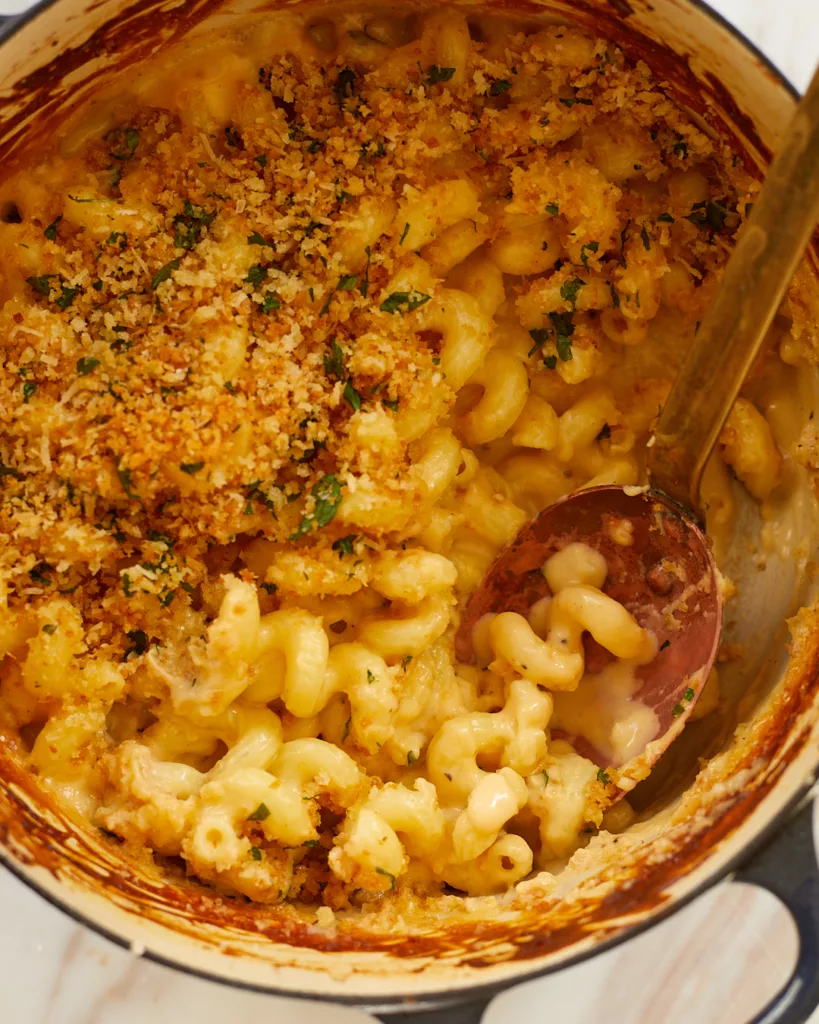
Here are 3 tips for making 4-cheese mac and cheese:
1. Finely grating your cheeses will help them melt easier and faster. Like melting chocolate, the heat from the cream can melt smaller pieces faster than bigger ones, which prevents you from having to reheat the mixture and risk it splitting.
2. Mise en place. Having every ingredient measured out (or grated) and ready to go will prevent you from frantically grating cheese when the béchamel is thickening or burning your roux waiting for the milk and cream.
3. Seriously, choose your cheese wisely. So much of what determined my success in most of these tests boiled down to which cheeses I was using. Read above for more information on which ones I found worked well, and other good signs to look for.
4. If some of the cheese isn’t melting into your sauce, that’s okay. Don’t just crank up the heat on the stove and keep cooking it until it melts. The heat from the sauce will most likely be enough to melt all the cheese, and if some of it doesn’t, that is probably caused by the cheese being too stretchy and stringy. Just keep stirring, off the heat, and if there are a few lumps, just roll with it. It will turn out fine.
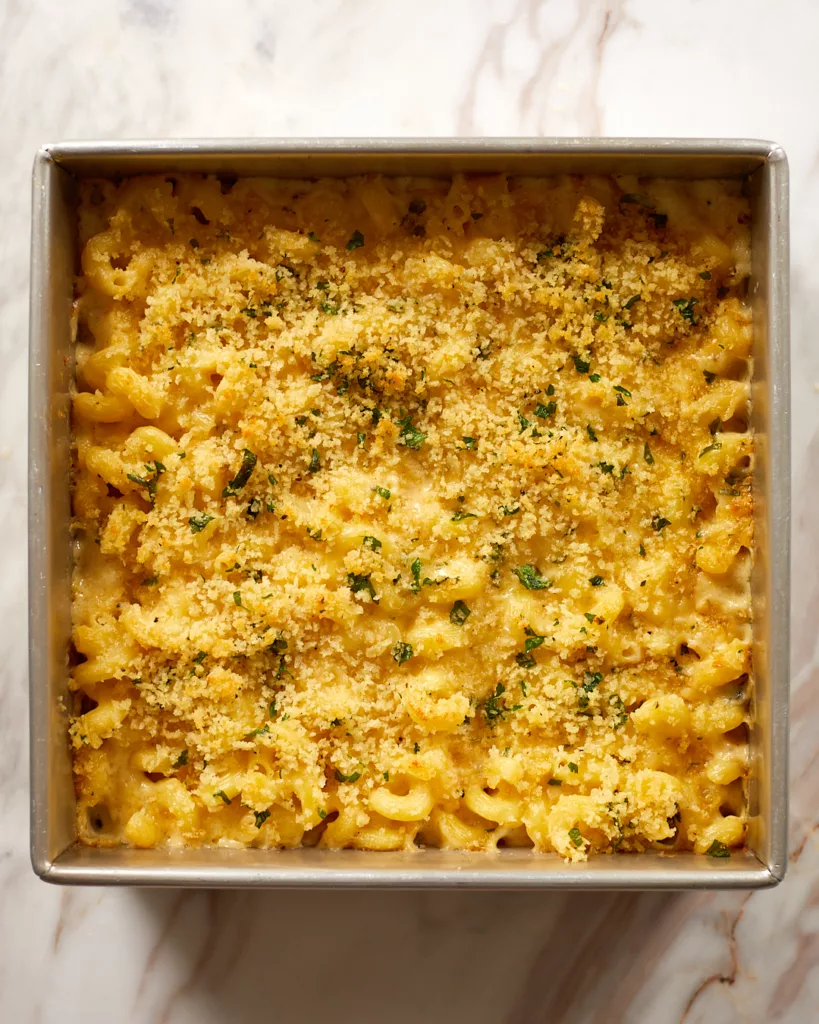
For a crispier top, you can also bake the mac and cheese in a buttered 9×9-inch tin or similar-sized baking dish. Or, if your sauce pan is big enough and oven-safe, you can mix your pasta and cheese sauce in there, top with breadcrumbs and transfer it straight to the oven.
Did you make this 4-Cheese Mac and Cheese? I want to see! Tag me @easygayoven on Instagram and TikTok.

4-Cheese Mac and Cheese
Ingredients
Breadcrumb topping
- 2 tablespoons unsalted butter
- 1/2 cup panko breadcrumbs
- 1/4 cup parmesan cheese finely grated (preferably parmigiano-reggiano)
- Kosher salt
- 1 tablespoon chopped fresh parsley
Mac and Cheese
- ½ pound cavattappi or other tubed pasta
- 3 tablespoons flour 25 grams
- 3 tablespoons butter 42 grams
- 1 cups whole milk 237 milliliters
- 1 cup heavy cream 237 milliliters
- 1/4 teaspoon garlic powder
- 1/4 teaspoon dry mustard
- 1/4 teaspoon paprika
- 1/2 teaspoon kosher salt
- ½ tsp black pepper
- 8 ounces white cheddar cheese finely shredded (2 1/4 cups) (I used Kerrygold Kilaree)
- 4 ounces Fontina cheese finely shredded (1 heaping cup)(I used Mitica Fontina Val D’Aosta)
- 4 ounces Gruyère cheese shredded (1 cup) (I used Emmi Cave-Aged)
Instructions
- Preheat the oven to 350° F and move one rack on the second highest position.
- Make the breadcrumb topping. Heat the butter in the microwave just until melted. Pour over the bread crumbs and mix together with a fork until the crumbs are totally coated in butter. Mix in the salt, parsley and parmesan. Set aside.
- Bring a pot of salted water to a boil and cook the cavattappi until just before al dente. Drain and set aside.
- Make the roux. In a large sauce-pan, melt the butter in the pot on medium-low heat until it stops popping and fizzing, then dump in the flour. Continuously stir the butter and flour for just a minute until the raw flour smell has faded.
- Combine the milk and heavy cream in a glass measuring cup. Drizzle the liquid into the roux a little at a time, whisking to break up any lumps. Once the roux and the liquid are combined and starting to thicken, add more liquid. Repeat until all the liquid is added.
- Whisk in the paprika, dry mustard, garlic powder, salt and pepper and keep stirring until the mixture is thick enough to coat the back of a wooden spoon. Do not let the mixture boil. If the sauce is too hot, it will split when the cheese is added.
- Take the mixture off the heat (it should read between 140-180° F on an instant read thermometer).
- One handful at a time, add in the sharp cheddar and Fontina, stirring in between each addition until combined. If the mixture’s temperature drops too much, you can return it to the stove over very, very low heat (even the smallest burner) to encourage more cheese to melt, but overcooking the sauce at this point will cause it to split. If some of the cheese strands are not totally melting in, that’s okay. It’s better to have a few strands of unincorporated cheese in an emulsified sauce than a gritty, split soup.
- Off the heat, add the pasta to the cheese sauce, and fold it in. Then, fold in the shredded Gruyére just until evenly dispersed.
- Pour the mac and cheese into a greased 9×9-inch tin (or, if your sauce-pan is oven-safe and big enough, you can just bake the mac and cheese in that). and level it off. Sprinkle on the breadcrumb topping.
- Bake for around 22 minutes, or until the edges are bubbling and the top is just barely turning golden brown. The temperature in the center should be about 190-200° F.
- Allow to cool for about 5 minutes before serving.
Video
Leave a Reply
Let's keep in touch...
Newsletter subscribers receive early access to new recipes, my best recipe, culture and product recommendations, and updates on all things easygayoven.
(Plus, paid members receive a bonus, exclusive recipe every month!)
For even more, follow along on Instagram and TikTok @easygayoven and at easygayoven.substack.com
© easygayoven 2022 | design by tonic
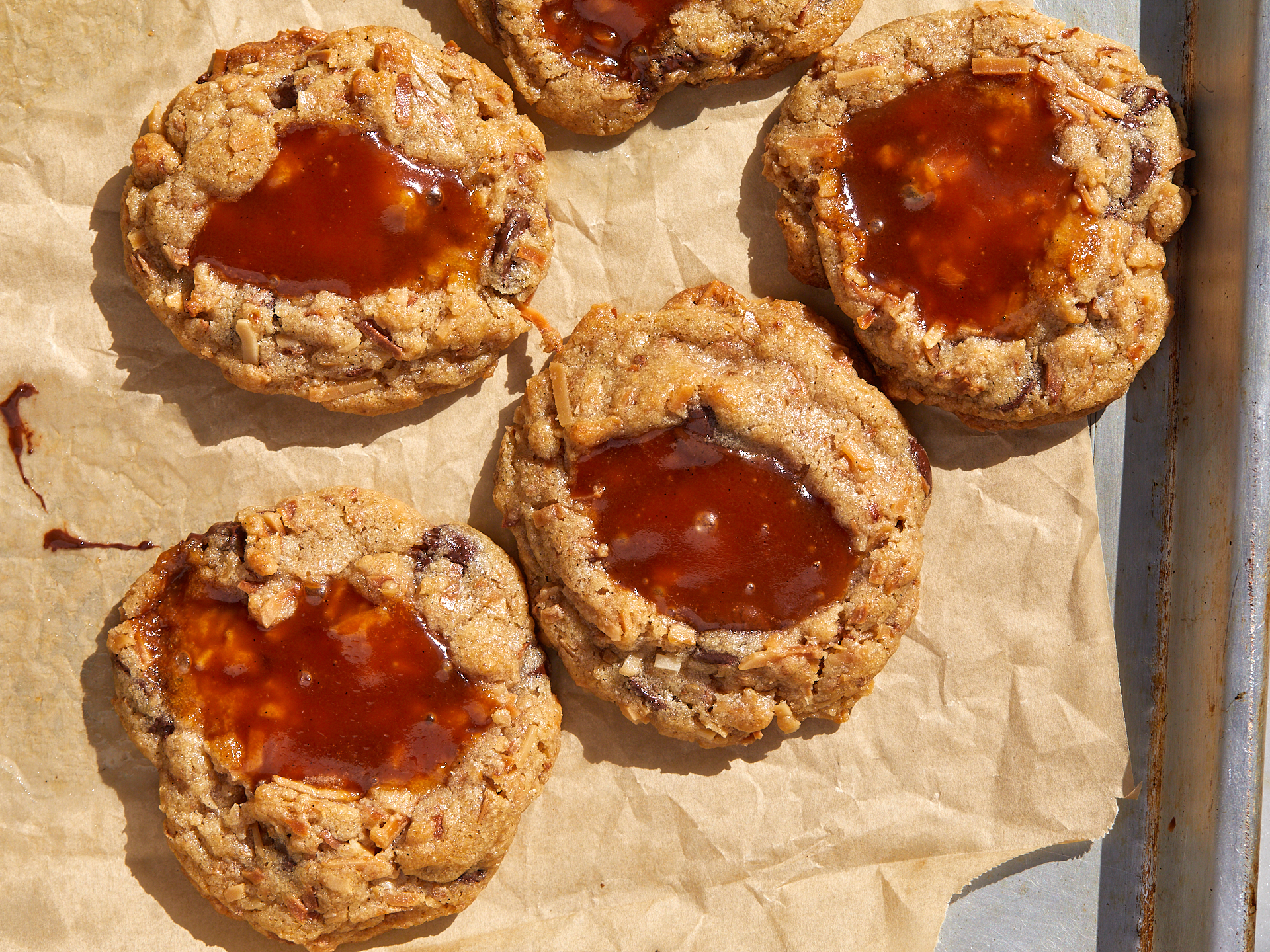
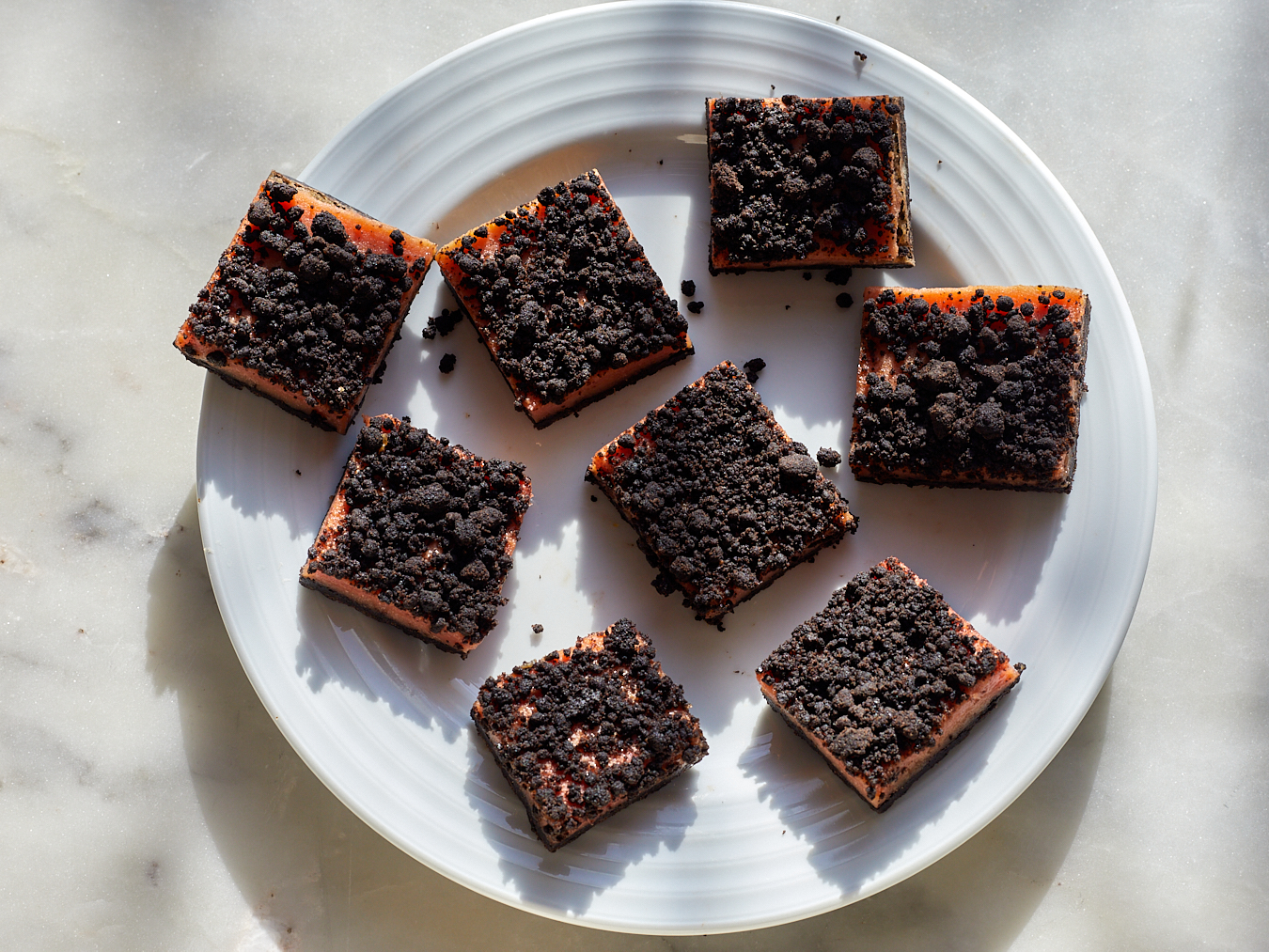
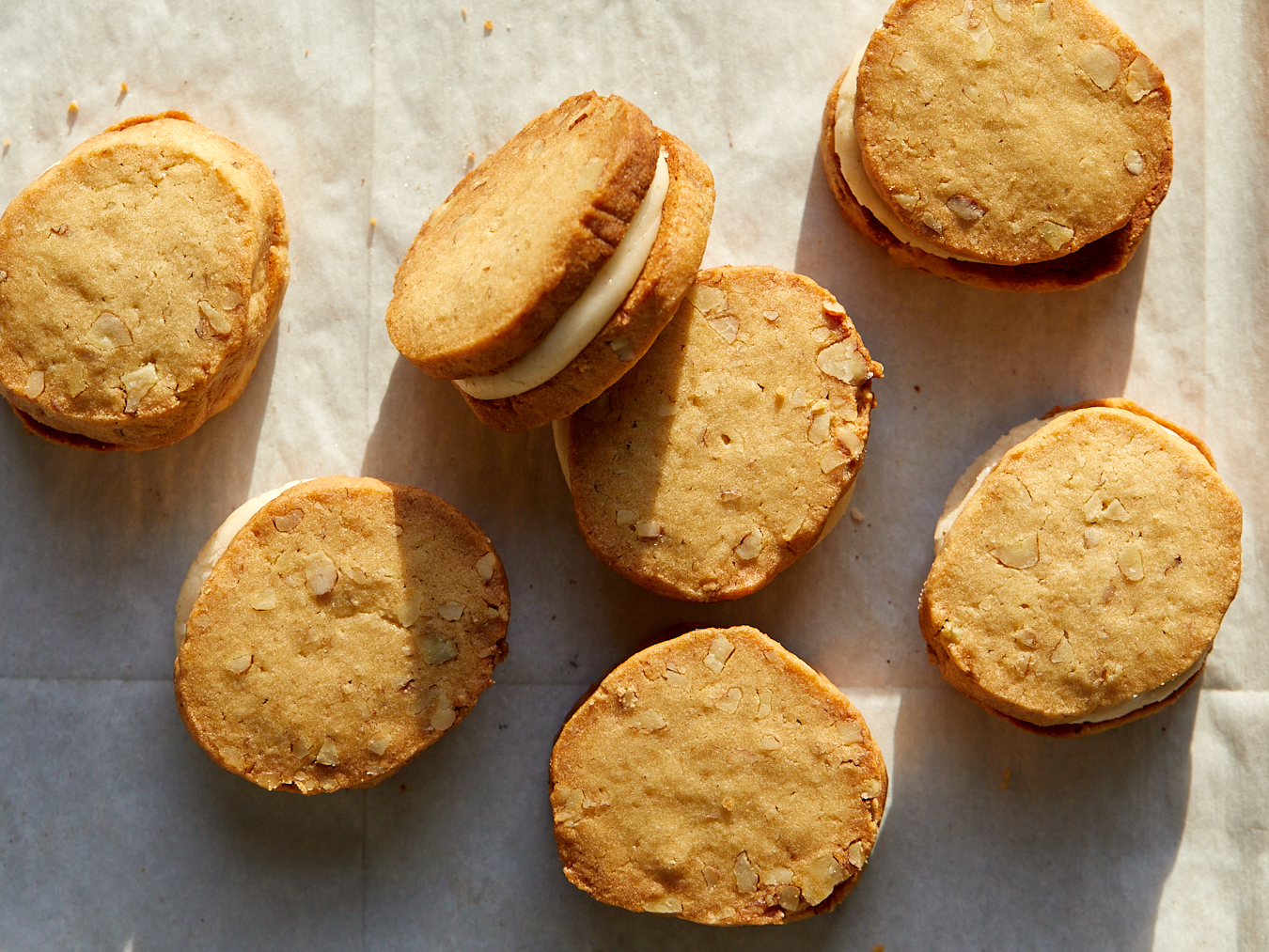
The BEST homemade mac & cheese recipe I’ve tried to date! Easy to make and every delicious detail is superb! Especially the addition of parmesan cheese to the topping *chef’s kiss*. Keep the savory recipes coming!!!
Thank you so much, Meg! I will try to keep the savory stuff coming!
—Eric
Boyfriend says this is the best Mac and cheese he’s EVER had and wants me to make it for Thanksgiving. Can the recipe be doubled and put in one large container or is it best to keep it in 2 separate containers? Not sure if it would effect cooking time to have a larger or thicker surface area.
I’m so glad it’s a hit for you guys! I haven’t tried doubling it, but I would put the noodles in one of those big 19×11 foil dishes (or a ceramic one if you have one big enough) cook the sauce in a wide, big dutch oven, and mix it in the dish, top it and bake it. It will probably bake in the same amount of time, but just watch for the cues “until the edges are bubbling and the top is just barely turning golden brown”
—Eric
Delicious and easy! The sauce is actually enough to lusciously coat a whole pound of pasta if you’re not gonna bake it (though it is also exceptional when made as written – my fam just has something against baked Mac and Cheese idk they’re heathens). Thanks for this great recipe!
Hahaha I totally agree nothing wrong with unbaked mac ‘n’ cheese! Glad you loved it and thanks for trying it! —Eric
My daughter is heading back to university and requested “the cheesiest mac’n’cheese possible” — I found your recipe and now I can’t print the words being uttered by her. IT’S A MOMENT over here lolol
Never has there been a mac’n’cheese this good. Ever.
The recipe tips are spot on — and the roux got “coat a wooden spoon” thick without boiling. Low heat and then off heat, as you said.
Holy crap is this amazing! Thank you!!!
I’m so happy you loved it! Thank you for your review —Eric